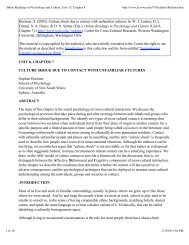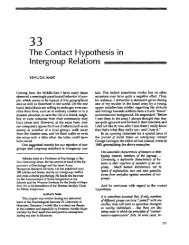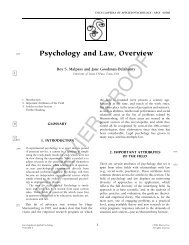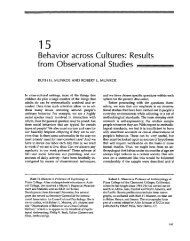From the Lab to the Police Station - Eyewitness Identification Lab ...
From the Lab to the Police Station - Eyewitness Identification Lab ...
From the Lab to the Police Station - Eyewitness Identification Lab ...
Create successful ePaper yourself
Turn your PDF publications into a flip-book with our unique Google optimized e-Paper software.
ties" (p. 32). We believe that <strong>the</strong> latter instruction is especially<br />
important in making it clear <strong>to</strong> eyewitnesses that it is<br />
not only acceptable <strong>to</strong> make no selection, but not finding<br />
<strong>the</strong> perpetra<strong>to</strong>r in <strong>the</strong> lineup could be a critical step in<br />
freeing an innocent suspect. Indeed, using Bayesian analyses<br />
with eyewitness identification data, we have shown<br />
that nonidentifications can be at least as diagnostic of<br />
innocence as identifications are of guilt (Wells & Lindsay,<br />
1980). Nonidentifications frequently are not recorded and<br />
are commonly undervalued in spite of <strong>the</strong>ir diagnostic<br />
value (Leippe, 1985).<br />
Avoiding postidentificatian suggestions.<br />
Importantly, <strong>the</strong> lineup sections include not only warnings<br />
against suggestion prior <strong>to</strong> <strong>the</strong> selection but also warnings<br />
against suggestion that can occur after a selection. Specifically,<br />
<strong>the</strong> Guide states, "If an identification is made, avoid<br />
reporting <strong>to</strong> <strong>the</strong> witness any information regarding <strong>the</strong><br />
individual he/she has selected prior <strong>to</strong> obtaining <strong>the</strong> witness'<br />
statement of certainty" (pp. 31, 35). The latter instruction<br />
is meant <strong>to</strong> prevent <strong>the</strong> type of confidence inflation<br />
that results from informing eyewitnesses that <strong>the</strong><br />
person <strong>the</strong>y selected is <strong>the</strong> suspect in <strong>the</strong> case, confirming<br />
that o<strong>the</strong>r witnesses selected this person, or passing along<br />
o<strong>the</strong>r information that is known <strong>to</strong> heavily influence eyewitnesses'<br />
statements about <strong>the</strong>ir identification. Although<br />
eyewitnesses will eventually know whe<strong>the</strong>r <strong>the</strong> person <strong>the</strong>y<br />
identified is <strong>the</strong> suspect in <strong>the</strong> case or merely a filler, <strong>the</strong><br />
Guide calls for <strong>the</strong> eyewitnesses <strong>to</strong> make a statement of<br />
<strong>the</strong>ir certainty prior <strong>to</strong> learning that information.<br />
The sequential lineup. As described earlier<br />
(see <strong>Identification</strong> Memory System Variables), <strong>the</strong> sequential<br />
lineup is superior <strong>to</strong> <strong>the</strong> simultaneous lineup. Although<br />
<strong>the</strong> Guide does not call for all lineups <strong>to</strong> be conducted using<br />
<strong>the</strong> sequential method (see <strong>the</strong> later section entitled Shortcomings),<br />
<strong>the</strong> sequential method is clearly described for<br />
both pho<strong>to</strong> lineups and live lineups. Even without requiring<br />
<strong>the</strong> sequential method, <strong>the</strong> Guide's introduction of <strong>the</strong><br />
sequential lineup method is, we believe, critical for two<br />
reasons. First, its presence in <strong>the</strong> Guide legitimizes its use.<br />
Many of <strong>the</strong> law enforcement members of <strong>the</strong> working<br />
group were concerned that <strong>the</strong>y could not simply choose on<br />
<strong>the</strong>ir own <strong>to</strong> use <strong>the</strong> sequential method, because <strong>the</strong> simultaneous<br />
method is <strong>the</strong> traditional standard. By giving a<br />
clear description of <strong>the</strong> sequential method as an alternative<br />
<strong>to</strong> <strong>the</strong> simultaneous method, <strong>the</strong> Guide gives law enforcement<br />
officers a credible source <strong>to</strong> point <strong>to</strong> (o<strong>the</strong>r than <strong>the</strong><br />
psychological literature) when arguing for <strong>the</strong> sequential<br />
method's use. Second, <strong>the</strong> presence of <strong>the</strong> sequential<br />
method in <strong>the</strong> Guide paves <strong>the</strong> way for future versions of<br />
<strong>the</strong> Guide <strong>to</strong> give <strong>the</strong> sequential method its due place as <strong>the</strong><br />
preferred method for conducting lineups.<br />
There are o<strong>the</strong>r important features of <strong>the</strong> Guide in<br />
addition <strong>to</strong> <strong>the</strong>se, of course. For instance, <strong>the</strong> Guide states<br />
that <strong>the</strong> investiga<strong>to</strong>r must "record both identification and<br />
nonidentification results in writing, including <strong>the</strong> witness'<br />
own words regarding how sure he/she is" (p. 38). Investiga<strong>to</strong>rs<br />
frequently do not use <strong>the</strong> witness's own words but<br />
instead make a summary statement. The failure <strong>to</strong> record<br />
<strong>the</strong> witness's actual words is especially problematic when<br />
<strong>the</strong> witness does not pick <strong>the</strong> suspect. In such cases, a<br />
common practice of police is <strong>to</strong> enter a report stating<br />
something like, "Witness could not make a positive identification<br />
of <strong>the</strong> suspect." This is uninformative at best, and<br />
it is quite misleading if <strong>the</strong> witness had actually said, "The<br />
person I saw is not in this lineup."<br />
Shortcomings<br />
It should come as no surprise that <strong>the</strong> final product was not<br />
what eyewitness researchers would consider ideal. There<br />
were two shortcomings that deserve particular mention.<br />
First, in both our writings (e.g., see Wells et al., 1998) and<br />
our presentations in <strong>the</strong> working group, we argued fervently<br />
for double-blind testing, that is, <strong>the</strong> person who<br />
administers a lineup should not be aware of which person<br />
in <strong>the</strong> lineup is <strong>the</strong> suspect. Currently, in most jurisdictions,<br />
<strong>the</strong> police investiga<strong>to</strong>r in charge of <strong>the</strong> case conducts pho<strong>to</strong><br />
lineups and participates in <strong>the</strong> running of live lineups.<br />
Hence, <strong>the</strong> investiga<strong>to</strong>r knows which person in <strong>the</strong> lineup is<br />
<strong>the</strong> suspect. The investiga<strong>to</strong>r's verbal and nonverbal behaviors<br />
provide considerable opportunity <strong>to</strong> inadvertently influence<br />
<strong>the</strong> witness both before <strong>the</strong> identification and immediately<br />
after <strong>the</strong> witness makes a choice (see Phillips,<br />
McAuliff, Kovera, & Cutler, 1999). The idea of doubleblind<br />
testing is, of course, well unders<strong>to</strong>od and accepted in<br />
scientific circles. Still, police and prosecu<strong>to</strong>rs put up a<br />
strong and successful fight <strong>to</strong> keep double-blind testing out<br />
of <strong>the</strong> Guide. The police were quite concerned that <strong>the</strong>ir<br />
peers would be insulted by a requirement for double-blind<br />
testing, because it would be construed as a statement that<br />
police are not <strong>to</strong> be trusted <strong>to</strong> conduct <strong>the</strong>ir own investigations.<br />
This was something that <strong>to</strong>ok us by surprise, because<br />
double-blind testing is a familiar precaution against inadvertent,<br />
ra<strong>the</strong>r than intentional, influence in psychological<br />
research. Although <strong>the</strong> police members of <strong>the</strong> working<br />
group realized that our call for double-blind testing was not<br />
a statement about trust, <strong>the</strong>y remained reluctant <strong>to</strong> advocate<br />
double-blind testing <strong>to</strong> <strong>the</strong>ir peers. They felt <strong>the</strong>ir peers<br />
would interpret <strong>the</strong> recommendation <strong>the</strong> same way that<br />
<strong>the</strong>y had, namely, as a statement that police could not be<br />
trusted.<br />
In addition, <strong>the</strong> police members of <strong>the</strong> working group<br />
argued that it would be impractical or expensive <strong>to</strong> require<br />
double-blind testing. We argued that any person who did<br />
not know which lineup member was <strong>the</strong> suspect could be<br />
used in place of <strong>the</strong> case investiga<strong>to</strong>r (e.g., a dispatcher, a<br />
secretary). The prosecu<strong>to</strong>rs countered that this would require<br />
that <strong>the</strong> person appear at trial and give testimony,<br />
something for which <strong>the</strong> person is not trained, and that this<br />
would add <strong>to</strong> <strong>the</strong> expense and logistical difficulties of <strong>the</strong><br />
entire endeavor. Technological developments are likely <strong>to</strong><br />
solve <strong>the</strong>se concerns ra<strong>the</strong>r easily, at least for pho<strong>to</strong> lineups,<br />
by allowing <strong>the</strong> lineups <strong>to</strong> be administered by a<br />
computer.<br />
Double-blind testing did not make it in<strong>to</strong> <strong>the</strong> guide as<br />
a recommendation. However, even though <strong>the</strong> Guide does<br />
not call for double-blind testing, <strong>the</strong> introduction <strong>to</strong> <strong>the</strong><br />
Guide states:<br />
594 June 2000 ° American Psychologist







